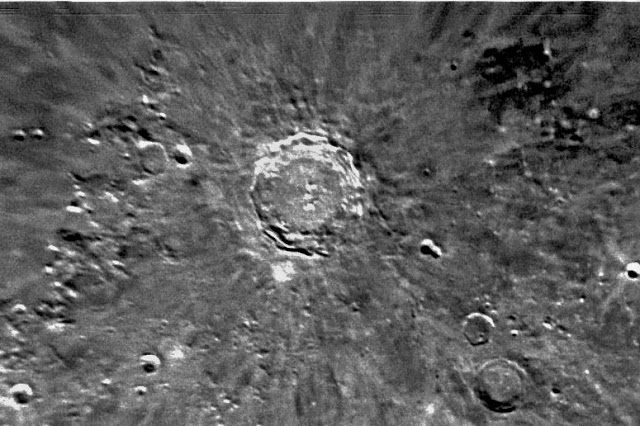 |
| Craters at lunar terminator © 2020 Purnendu Gupta |
The moon's craters, seen in the lunar twilight zone. At the lunar terminator, fading sunlight meets near perfect darkness of an airless lunar night disturbed only by the faint glow of earthshine. The grazing rays cast long shadows into the crater pits as the edge of light creeps up the shallow slopes to the rims on the far side.
On the 3rd of December 2020, this was among the first results from my attempt at high magnification video based lunar imaging.
Ego Wall
Lunar craters like these have been mapped and named by the hundreds. The moon is perhaps the only place where such unprecedented density of landmarks named after astronomers, mathematicians and scientists from the world over jostle for space. If the names were somehow visible from space - the moon would look like earth’s own floating “ego wall”.
However, I was too absorbed taking in the sights to collect orienting information to be able to identify the features in the shot. But identified or not, these giant hollows are remnants of a violent and fiery cosmic past. Quiet mausoleums where nothing but shadows move, yet formed at a time when hell rained down from the skies excavating hollows the size of large modern cities - in an instant.
Copernicus
My rendezvous with Copernicus, began a few nights after I took the image above. I have always been fascinated by Tycho at the bottom edge of this image below. Tycho's rays of ejecta are an unmistakable sight seen through binoculars - but was not somehow photogenic. Copernicus on the other hand, seen here on a waning gibbous moon, stared back as if trying to nudge me silently on to its mysteries.
 |
| Waning gibbous moon © 2020 Purnendu Gupta |
The image below is a higher magnification version of the wider shot above. Created from hundreds of frames in a 22 second video clip taken by a camera attached to a telescope. To be precise, an SLR attached to a 24 mm eyepiece in prime focus mode to 5 inch Maksutov Cassegrain. This planetary video imaging technique reduces atmospheric turbulence using software algorithms to reveal clarity and resolution that rivals images from lunar orbiters.
 |
| Copernicus Crater and ray system © 2020 Purnendu Gupta |
Copernicus surrounded by many smaller satellite craters and craterlets. Sometimes one inside another probably from a string of overlaid impacts. Rays of ejected material from the impact debris radiate for hundreds of miles from the center. Below is a crop of the above image. Seen at the center are three peaks that rise from the crater floor up to 800 metres (2,600 feet) high, just short of the Eiffel tower. These were probably formed as a result of a rebound of deep-seated rocks at the site of meteor impact less than a billion years ago.
 |
| Copernicus Crater close up © 2020 Purnendu Gupta |
Copernicus is 96 kms (58 miles) across and could fit a large city such as Los Angeles (44 miles long and 29 miles wide) comfortably inside.
For an earthly reference here is a picture of one of the most well preserved craters on earth, the Meteor crater (Barringer Crater) in Arizona - which I visited first in 2008. It is just over 1 km in diameter, seen in the aerial shot here with a winding road leading up to the visitor center.
 |
Meteor Crater near Winslow, Arizona. This crater is ~1.2 km in diameter and ~170 meters deep:
Source NASA |
Majestic as it looks, the Meteor crater is tiny in comparison with the goliath that is Copernicus. In this map below of Copernicus and its satellites, the tiny dots at the spots marked A and F are each craters ~3 km in diameter. These barely visible features would still be three times the size of the Meteor crater here on earth.
 |
| Source: Андрей Щербаков, CC BY-SA 4.0, via Wikimedia Commons |
Bose
Apparently the powers that name lunar craters were not shy of recognizing the worthy from beyond the western world. In fact, they were sometimes given the same status (as far as feature size goes) as some western counterparts. One such is the Indian scientist Sir Jagadish Chandra Bose (not to be confused with the other Bose of Boson fame) with a crater to his name. The Bose crater, at 91 km. diameter, is almost the same size as Copernicus.
 |
Oblique Lunar Orbiter 5 image of Bose (upper right) and Bhabha
(lower left) craters on the lunar dark side. Source: Jstuby
at English Wikipedia, CC0, via Wikimedia Commons |
The eponymous Bengali, an eminent polymath who lived at the turn of the 20th century was perhaps best known for his investigations into wireless radio and microwave optics. His pioneering demonstration in 1895 of wireless signaling used the little understood phenomenon called radio waves. He called the light like yet invisible thing "Adrishya Alok" (invisible light). In fact the work of this little remembered man lay the foundations of modern day wireless radio communications.
The legacy of Bose lives on, among other earthly giants, out of sight, on the dark side of the moon.







No comments:
Post a Comment